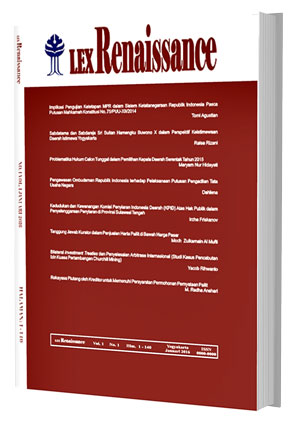Main Article Content
Abstract
This study aims to construct legal reform in the disclosure of cases of corruption which tend to be massive and hidden. This study aims to reach the formulation of regulation of corruption case disclosure in the digital era in the form of a strategy to eradicate corruption by using the interception method by the Prosecutor's Office in accordance with the laws and regulations after the Constitutional Court decision Number 5/PUU-VIII/2010. This research uses normative methods through laws and regulations, books and documents. The results of the study conclude, first, that the interception authority in the digital era by prosecutors as investigators, investigators, public prosecutors and executors in eradicating corruption has not received legal legitimacy, so that with the broad authority of the Attorney General's Office and the structure that has been spread throughout Indonesia, it is now necessary supported by the interception authority. Second, the formulation of interception regulation for prosecutors in the future needs to be regulated in a statutory level, and regulated in detail in order to accommodate and limit the authority of law enforcement officials, especially prosecutors in conducting interception.
Keywords
Article Details
Authors who publish with this journal agree to the following terms:
a. Authors retain copyright and grant the journal right of first publication with the work simultaneously licensed under a Creative Commons Attribution License that allows others to share the work with an acknowledgement of the work's authorship and initial publication in this journal.
b. Authors are able to enter into separate, additional contractual arrangements for the non-exclusive distribution of the journal's published version of the work (e.g., post it to an institutional repository or publish it in a book), with an acknowledgement of its initial publication in this journal.
c. Authors are permitted and encouraged to post their work online (e.g., in institutional repositories or on their website) prior to and during the submission process, as it can lead to productive exchanges, as well as earlier and greater citation of published work (See The Effect of Open Access).References
- Buku
- Subarsyah Sumadikara, T., Penegakan Hukum (sebuah pendekatan Politik hukum dan Politik Kriminal), Bandung, Kencana Utama, 2010.
- Kristian dan Yopi Gunawan, Sekelumit Tentang Hukum Penyadapan dalam Hukum Positif di Indonesia, Nuansa Aulia, Bandung, 2013.
- M. Hadjon, Philipus, Perlindungan Hukum bagi Rakyat di Indonesia, Peradaban, Surabaya, 2007.
- Makarim, Edmon, Komplikasi Hukum Telematika, PT. Raja Grafindo Persada, Jakarta, 2004.
- Jurnal
- Supriyadi Widodo Eddyono. “Mengurai Pengaturan Penyadapan dalam Rancangan KUHAP”, Jurnal Teropong, Vol. 1 Agustus 2014.
- Internet
- https://bobo.grid.id/read/08954863/kenapa-suara-manusia-terdengar-berbeda-beda-yuk-cari-tahu?page=all, pada tanggal 28 Februari 2020, pukul 16:26 wib
- Peraturan Perundang-undangan
- Undang-Undang Nomor 8 Tahun 1981 tentang Hukum Acara Pidana.
- Undang-Undang RI Nomor 30 Tahun 2002 tentang Komisi Pemberantasan Tindak Pidana Korupsi.
- Undang-Undang RI Nomor 16 Tahun 2004 tentang Kejaksaan RI.
- Undang-Undang RI Nomor 36 Tahun 1999 tentang Telekomunikasi.
- Peraturan Jaksa Agung RI Nomor: PERJA-039/A/JA/10/2010 tentang Tata Kelola Administrasi dan Teknis Penanganan Perkara Tindak Pidana Khusus.
- Rancangan Undang-undang Penyadapan
- Rancangan Undang-undang KUHAP
References
Buku
Subarsyah Sumadikara, T., Penegakan Hukum (sebuah pendekatan Politik hukum dan Politik Kriminal), Bandung, Kencana Utama, 2010.
Kristian dan Yopi Gunawan, Sekelumit Tentang Hukum Penyadapan dalam Hukum Positif di Indonesia, Nuansa Aulia, Bandung, 2013.
M. Hadjon, Philipus, Perlindungan Hukum bagi Rakyat di Indonesia, Peradaban, Surabaya, 2007.
Makarim, Edmon, Komplikasi Hukum Telematika, PT. Raja Grafindo Persada, Jakarta, 2004.
Jurnal
Supriyadi Widodo Eddyono. “Mengurai Pengaturan Penyadapan dalam Rancangan KUHAP”, Jurnal Teropong, Vol. 1 Agustus 2014.
Internet
https://bobo.grid.id/read/08954863/kenapa-suara-manusia-terdengar-berbeda-beda-yuk-cari-tahu?page=all, pada tanggal 28 Februari 2020, pukul 16:26 wib
Peraturan Perundang-undangan
Undang-Undang Nomor 8 Tahun 1981 tentang Hukum Acara Pidana.
Undang-Undang RI Nomor 30 Tahun 2002 tentang Komisi Pemberantasan Tindak Pidana Korupsi.
Undang-Undang RI Nomor 16 Tahun 2004 tentang Kejaksaan RI.
Undang-Undang RI Nomor 36 Tahun 1999 tentang Telekomunikasi.
Peraturan Jaksa Agung RI Nomor: PERJA-039/A/JA/10/2010 tentang Tata Kelola Administrasi dan Teknis Penanganan Perkara Tindak Pidana Khusus.
Rancangan Undang-undang Penyadapan
Rancangan Undang-undang KUHAP




